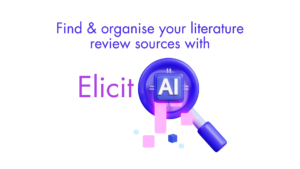
A few months ago, I discovered Elicit AI. Elicit’s superpowers of organisation and summary complement Google Scholar’s advanced searches as well as Research Rabbit’s networks and timelines. With these tools, my literature search toolkit is now complete.
Join me on Thursday evening 6th June @6:00 (GMT+2:00) when I take you through some of the features of Elicit. You can try it out during the session using your research question and the credits that come on its free plan.
Before I tell you about Elicit, I must emphasise that there is no substitute for accessing and reading the key papers in your field in full. Without doing so, you will miss out on the key debates and the insights of influential authors.
Now, let’s dive into Elicit.
Elicit has three main workflows. It finds papers based on a research question you enter, extracts data from PDFs you upload (they say you can upload 100 PDFs at once), and it generates a list of concepts across papers.
Part of Elicit’s superpowers is that it can take the papers it finds or those you upload, and summarise and organise their features into a potentially giant matrix that would have taken you, or a team of assistants, endless hours to compile. Each row of the matrix represents a paper, and each column corresponds to a criterion of your choice. For example, you can choose to add columns for each of the papers’ objectives, research questions, theoretical frameworks, methodologies, study designs, populations, hypotheses, statistical techniques, main findings, intervention effects, limitations, and many other criteria – even your custom ones.
Elicit’s organisational work thus provides you with a high-level yet detailed overview and summary of the features of papers related to your research question. You are then well-prepared to write your literature review at the elevated level expected in postgraduate research.
Elicit integrates with Zotero and provides links to the original open-source papers or abstracts (for those behind paywalls). Once again, you can–and should–click into the papers, check the sources, and read key ones.
Elicit’s other workflow–generating concepts–is even more impressive. But, I’ll leave that for another post.
With all this going for Elicit, why would I keep Google Scholar and ResearchRabbit AI in my toolkit?
Well, they serve different purposes. Google Scholar is my comfort zone where I feel in control of my searches using its advanced searches and metrics. ResearchRabbit AI shows me themes or clusters of papers and authors, and a timeline that I find very useful for tracing the evolution of my topic. Plus, both tools are free so I can research without financial care.
Elicit is not free, although it does offer initial credits for limited searches. But sometimes one smiles when one pays for a truly remarkable product. I did.